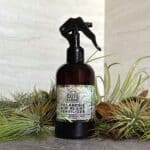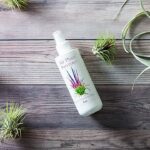Have you recently noticed that Tillandsia plants are getting yellow with stunted growth? Perhaps, you may have skipped the dose of Tillandsia food.
If you have been stressing over your wearied Tillandsias where nothing seems to be working, you have come to the right place.
Read on to find out which fertilizer does best for your Tillandsias.
Table of Contents Show
Does All Tillandsia Need Fertilizer?
Tillandsia air plants are low-maintenance Bromeliads. Air plants are epiphytes, meaning they grow on tree or shrub branches rather than soil.

It is not necessary to fertilize air plants, but there are several advantages to doing so.
Air plants only bloom once in their lives and produce “pups,” or little offsets, from the mother plant after they bloom.
Feeding air plants promote blooming and the reproduction of new offsets, resulting in new plants’ formation.
Air plants like Tillandsia usually don’t thrive for fertilizers. However, the absence of fertilizer might reduce its life span, and you may not see the pups.
So, if you want to accelerate the offsets production, help it bloom fast and easy, and encourage proper growth, then switch to a fertilizer.
Signs Your Tillandsia Needs Fertilizers
Plants have a way of showing stress when we don’t provide them with enough fertilizers. You should look out for the signs and act accordingly.
- The plant’s foliage looks pale and weak, which shows the lack of nitrogen.
- Chlorosis (leaves appear yellow, and the veins look darker) indicates the need for potassium.
- The plant’s growth is slowed or halted even during the growing seasons.
- You’ll start to see small spots on leaves that grow with time, resulting in discoloration.
- Mature leaves turn purple at the base, and other leaves exhibit dull, dark-green colors. This shows that the plant needs phosphorus.
Best NPK Values of Fertilizer for Tillandsia
The optimal NPK formation for Tillandsia is 17-8-22. This shows the ratio of 17%, 8%, and 22% of nitrogen, phosphorus, and potassium, respectively.
Other micronutrients occupy the remaining 53% in varying quantities. Lack of NPK renders the following symptoms!
- Nitrogen: The plant looks yellow and pale, and the root/shoot ratio decreases.
- Phosphorus: Leaves turn dark green, and dull, reddish color develops in plants.
- Potassium: Brown and curling leaf tips, chlorosis.
Besides the primary macronutrients (Nitrogen, Phosphorus, Potassium), plants need other macronutrients like Calcium and sulfur.
The plants get macronutrients like Hydrogen, Oxygen, and Carbon from water. Macronutrients are required in great quantity for plants, while plants can do with fewer micronutrients.
| Nutrients | Roles |
|---|---|
| Nitrogen | Provides energy to plant whenever they need it. |
| Phosphorus | Helps in formation of new tissue and cell division. |
| Potassium | Promotes root growth and drought tolerance. |
| Hydrogen | Helps to build sugar and produces glucose. |
| Oxygen | Helps in cellular respiration. |
| Carbon | Promotes healthier and productive growth. |
| Calcium | Produces plant tissues and improves growth. |
| Sulphur | Helps in formation of proteins, amino acids and oils. |
| Manganese | Sustains metabolic role in plants. |
What is the Best Fertilizer to Use for Tillandsia?
Low-nitrogen fertilizers are one of the best types of air plants. Scientifically, it’s said that crops with low nitrogen tend to produce more antioxidants than those with high nitrogen levels or urea.
Try going for Bromeliad fertilizer or air-plant fertilizer for better results. Many fertilizers are available on the market.
Types of Fertilizer for Tillandsia
Various kinds of fertilizers are available on the market. Some examples are granular, liquid, slow-release, spike, foliar, etc.
- Granular: Granular fertilizers come in dry, pellet forms. When it comes to Tillandsia, you can go for low-nitrogen granular fertilizers. But make sure to dilute it to 1/4 of the recommended strength.
- Liquid: These fertilizers come in liquid form and can be injected directly into the soil. Tillandsia does best if liquid fertilizer is added to its nutrition.
As the plant doesn’t have a dire requirement for fertilizer, you can opt for slow-release liquid fertilizer. Though, it’s very uncommon.
When and How Often Should you Fertilize Tillandsia?
Fertilize your Air plant with low-nitrogen spray fertilizer once a month during its growing seasons, i.e., spring and summer.
If you use bromeliad fertilizer or air plant-specific fertilizer, you can fertilize your plant a few times a year.

Avoid over-fertilizing your plants, or you may end up burning the plant and pushing it one inch closer to its untimely death.
It’s recommended not to fertilize your plant during the winter because it develops slowly and doesn’t require many nutrients. If you do, you risk over-fertilizing your plant and burning it.
Top 5 Best Fertilizers for Tillandsia
Let’s look at our recommended fertilizers for your Tillandsia.
| Fertilizers | Features | Image |
|---|---|---|
| The Grow Co.-Organic Ready to Spray Air Plant Food | 1 Fully organic 2. Enhances plant 3. Free of urea 4. Pre-mixed Fertilizer |  |
| Cute Farms Tillandsia Air Plant Fertilizer | 1. Made for air plants 2. Spray directly to plants 3. Great value for money |  |
| Aquatic Arts Air Plant Food | 1. Formulated for air plants 2. Makes watering easy 3.Long lasting |  |
| Air Plant Grower for Bromeliads | 1. Easy-to-use 2. Comes with air plant grower 3. Helps create new cells |  |
| The Drunken Gnome Tillandsia Air Plant Food | 1. Promotes growth, color and blossom 2. Includes mister |  |
How to Fertilize Tillandsia?
There are two ways to fertilize your air plant. They are: by misting and by soaking.
1. Fertilize Tillandsia by Misting
- Prepare the fertilizer in a tub and dilute it to 1/4th of the recommended strength. Mix it thoroughly.
- Clean the mister/sprayer for any residue or impure particles.
- Fill the mister with the prepared fertilizer solution.
- Spray the fertilizer at the top and underside of the leaves.
2. Fertilize Tillandsia by Soaking
- Take a clean tub and fill the bottom half with clean water.
- Mix the fertilizer you selected in the water. Remember, let the fertilizer to water ratio of 1:4.
- Stir the solution thoroughly before application. You can do these steps in a sink or a bathtub.
- Gently place the plant in the tub and let it sit there, and absorb water for an hour.
- Check the soil’s moisture level and if it is still dry, let it sit for a few minutes more.
- Remove the plant from the tub and place it on the paper towel with the crown facing down to drain the excess water.
If you do not want to fertilize your plant with commercial fertilizers and wish to do it naturally, you can go for aquarium or pond water.
A few minutes of dunking the pot in aquarium or pond water will work wonders.
You can also take the water from the aquarium and pond and fill it in a mister. Spray the water over the plant thoroughly.
Read more: How to Water Air Plants?
DIY Fertilizer for Tillandsia
Unlike chemical or commercial fertilizers, organic or DIY foods do not harm soil in any way.
Follow the following steps to prepare a fertilizer for the air plant at home.
- Take some moist, fresh moss to prepare for the process. You can order moss online or grow it by yourself. You can also find moss on trees, logs, or yards.
- Make sure the moss has 4-5 live strands.
- Make the moss resemble a granular fertilizer by giving it a fine chop.
- Prepare a mixture of 80% moss granules and 20% blood meal. Put the mixture in a plastic ziplock bag. If the blood meal settles at the bottom, give the bag a gentle shake.
- Do not keep the mix for too long. Use it as soon as possible.
- Add this mix to water and prepare a solution before dunking the plant.
If you have finished fertilizing Tillandsia plants, now learn how to care for Tillandsia!
From Editorial Team
How to Check if Fertilizers Functioned Well after Applying
It may take 1-5 days for Tillandsia plants to show the results after applying. The plant may revive to be lively after wilting.
You can learn the effect of fertilizers if the faded color of leaves turns dark green. Besides, well blooming is another sign of effective fertilizing.
